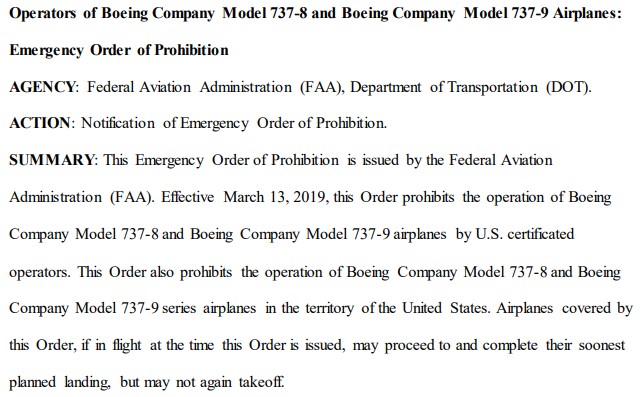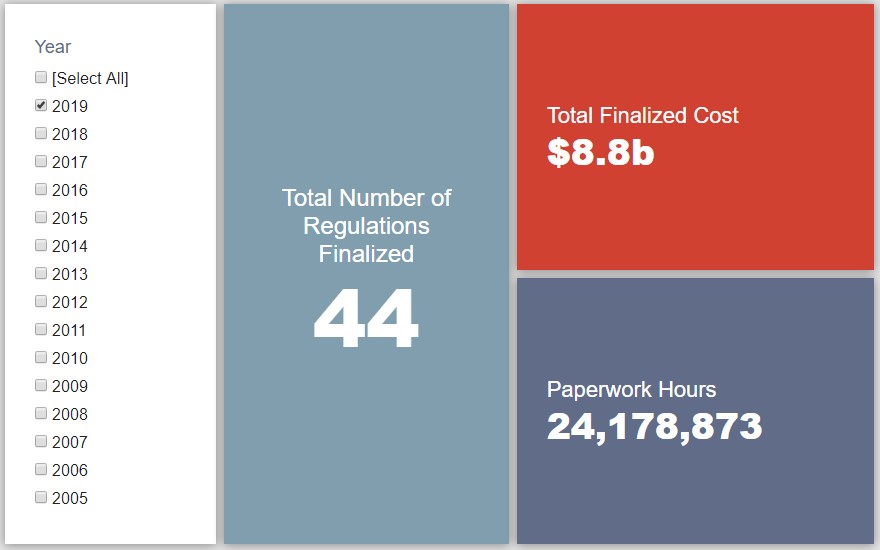Week in Regulation
March 18, 2019
Emergency Order Punctuates Otherwise Quiet Week
It was yet another net-regulatory week in the pages of the Federal Register – but just barely. Only four final rules had any quantified cost or paperwork burden estimates. Outside of those, the most notable regulatory action of the week was the emergency order grounding certain Boeing aircraft in light of recent crashes abroad. Between both proposed and final rules last week, agencies published $2.9 million in total net costs, as well as 54,748 hours of new paperwork.
REGULATORY TOPLINES
- New Proposed Rules: 30
- New Final Rules: 69
- 2019 Total Pages: 9,666
- 2019 Final Rule Costs: $8.8 Billion
- 2019 Proposed Rule Costs: $7.7 Billion
TRACKING THE REGULATORY BUDGET
There were no actions that contributed either costs or savings to the fiscal year (FY) 2019 regulatory budget established under Executive Order (EO) 13771. The highest cost total of the week came from an airworthiness directive regarding certain parts of Airbus SAS Airplanes. It brings estimated compliance costs of approximately $2.2 million. Given the routine and relatively minor effects of such directives, they do not factor into the EO 13771 tally.
So far in FY 2019 (which began on October 1, 2018), there have been 33 deregulatory actions (per the rubric created by EO 13,771 and the administration’s subsequent guidance document) against 14 rules that increase costs and fall under the EO’s reach. Combined, these actions yield quantified net costs of roughly $10.1 billion. This total, however, includes the caveat regarding the baseline in the Department of Agriculture’s “National Bioengineered Food Disclosure Standard.” If one considers that rule to actually be deregulatory, the administration-wide net total is approximately $3.4 billion in net costs. The administration’s cumulative savings goal for FY 2019 is approximately $18 billion.
THIS WEEK’S REGULATORY PICTURE
One can describe “regulatory policy” in many ways: mundane, opaque, monotonous, complex, legalistic. The list goes on. In order to help provide a clearer and more straight-forward view into this world, the American Action Forum will seek to provide a brief illustration of a notable regulatory trend we have identified in a given week. This week’s entry: the Federal Aviation Administration’s (FAA) Emergency Order of Prohibition regarding Boeing’s 737 MAX planes.

On March 13, the FAA acted to ground all flights involving Boeing’s 737 MAX airplanes after two tragedies in recent months that claimed the lives of more than 340 people. The move seemed inevitable as country after country grounded the planes, though the United States was the last major country to act. The FAA’s order prohibits U.S. operators from flying the plane until it issues an order rescinding the prohibition.
The action is noteworthy both for the severity of the situation and as an example of an effectively functioning regulatory system. The Administrative Procedure Act and executive orders covering the regulatory process wisely exempt emergency rules – including President Trump’s EO 13,771, which some characterize as prizing deregulation above all else. Though America was the last major country to act, it was not because of defects in the regulatory machinery.
The economic impacts of the decision are not trivial. Some analysts expect it to cost Boeing as much as $5 billion over the next two months, and the airline industry and passengers billions more. A rule with such an economic impact would typically be subject to the normal cost-benefit analysis and review process prior to promulgation. But the nature of the action demonstrates how swiftly America’s regulators can operate in an emergency.
TOTAL BURDENS
Since January 1, the federal government has published $16.5 billion in net costs (with $8.8 billion in finalized costs) and 22.9 million hours of net paperwork burden increases (including roughly 24.2 million hours from final rules). Click here for the latest Reg Rodeo findings.












